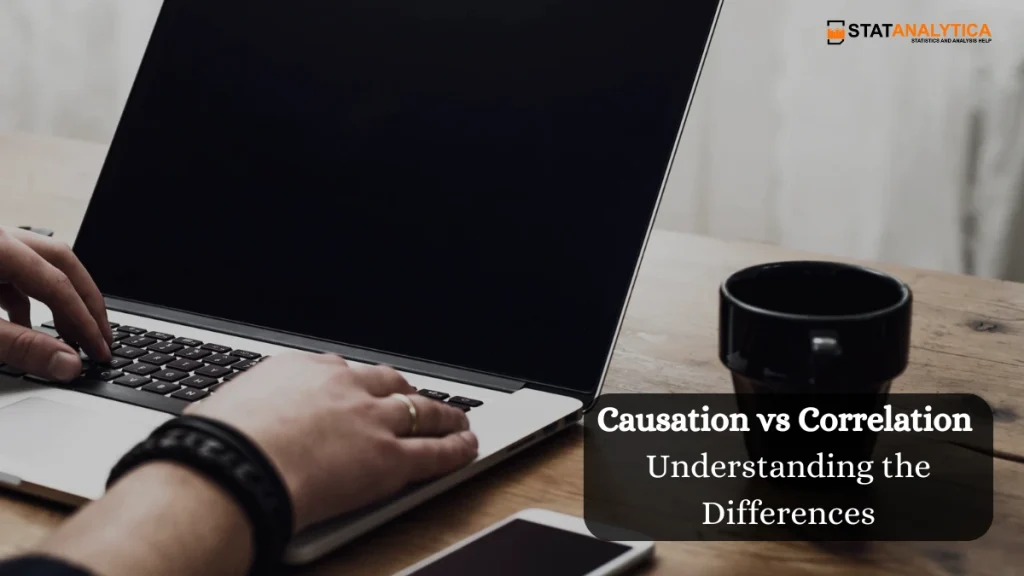When studying data, you might come across terms like causation and correlation. Though these terms may seem similar, they describe very different relationships between variables. Understanding the distinction between causation and correlation is essential for interpreting data correctly and making informed decisions. In this blog post, we will explore these concepts in detail, using simple language, examples, and visuals to help clarify Causation vs Correlation.
What is Correlation?
Table of Contents
Correlation refers to a relationship between two variables, where changes in one variable are associated with changes in another variable. In other words, when one variable changes, the other variable tends to change as well. However, correlation does not imply that one variable causes the change in the other.
Types of Correlation
- Positive Correlation: In a positive correlation, when one variable increases, the other variable also increases. For example, as the temperature rises, ice cream sales tend to increase. This type of correlation suggests that there is a direct relationship between the two variables.
- Negative Correlation: In a negative correlation, when one variable increases, the other variable decreases. For example, as the number of hours spent watching TV increases, the time spent studying tends to decrease. This indicates an inverse relationship between the two variables.
- Zero Correlation: Zero correlation means that there is no relationship between the two variables. For example, the amount of pizza consumed and the score on a math test may not correlate at all. Understanding zero correlation helps identify cases where no relationship exists.
Measuring Correlation
The strength and direction of a correlation can be measured using a correlation coefficient, which ranges from -1 to +1:
- 1: Perfect positive correlation
- 0.5: Moderate positive correlation
- 0: No correlation
- -0.5: Moderate negative correlation
- -1: Perfect negative correlation
Correlation Coefficient Table
| Correlation Coefficient | Strength of Correlation |
| +1 | Perfect positive correlation |
| +0.5 | Moderate positive correlation |
| 0 | No correlation |
| -0.5 | Moderate negative correlation |
| -1 | Perfect negative correlation |
Visualizing Correlation
You can visualize correlation using a scatter plot. A scatter plot shows individual data points for two variables on a graph. The pattern formed by these points can indicate the type of correlation:
- Positive correlation: Points move upwards from left to right.
- Negative correlation: Points move downwards from left to right.
- Zero correlation: Points appear scattered randomly across the graph.
Importance of Correlation
Understanding correlation is vital in various fields such as social sciences, business, and healthcare. It helps researchers identify relationships between variables, which can lead to further investigations or policy decisions. For example, a positive correlation between education levels and income could suggest that increasing educational opportunities may lead to higher incomes.
What is Causation?
Causation is a much stronger relationship than correlation. It indicates that one variable directly causes a change in another variable. When we say that A causes B, it means that if A changes, B will change as a result of that change.
Why is Causation Important?
Understanding causation is crucial because it helps us identify the actual reasons behind changes in variables. This knowledge allows us to make predictions and take actions based on what we know about the relationships between variables. For example, if we establish that smoking causes lung cancer, public health initiatives can be developed to reduce smoking rates and ultimately decrease lung cancer cases.
Establishing Causation
Proving causation is more challenging than establishing correlation. To demonstrate that one variable causes another, researchers typically rely on a few key criteria:
- Temporal Sequence: The cause (A) must occur before the effect (B). For example, if you want to say that exercise (A) causes weight loss (B), you must show that exercise happened before the weight loss occurred.
- Non-spurious Relationship: The relationship between A and B must not be due to other variables. For instance, if both exercise and weight loss are affected by a third variable like diet, then we cannot claim that exercise alone causes weight loss.
- Elimination of Alternative Causes: Researchers must demonstrate that no other factors are responsible for the observed relationship between A and B.
Example of Causation
Let’s consider a simple example to illustrate causation:
Example: If you take a pill (A) that is proven to relieve headaches (B), you can confidently say that taking the pill causes the headache to go away. Here, taking the pill precedes the relief from the headache, and there is no third variable influencing this outcome.
Real-World Examples of Causation
- Vaccination and Disease Prevention: Extensive research has shown that vaccinations (A) decrease the incidence of certain diseases (B). The temporal sequence is clear; vaccines are administered before the outbreak of the disease, and there are no third variables that cause the decrease in disease rates.
- Exercise and Improved Health: Numerous studies have shown that regular exercise (A) leads to improved physical health (B). This relationship is established through controlled experiments that eliminate other factors such as diet or genetics.
Correlation Does Not Imply Causation
One of the most important points to remember is that correlation does not imply causation. Just because two variables are correlated does not mean that one causes the other.
Examples of Misinterpreted Correlation
- Ice Cream Sales and Drowning Incidents:
- In summer, ice cream sales and drowning incidents tend to rise. However, one does not cause the other. The common factor is the warm weather, which leads people to buy ice cream and go swimming.
- Exercise and Skin Cancer:
- Imagine a study that finds that people who exercise more have higher rates of skin cancer. One might incorrectly conclude that exercise causes skin cancer. However, a lurking variable could be exposure to sunlight. People living in sunny areas tend to be more active and also have higher skin cancer rates due to sun exposure.
- Education and Income:
- A correlation may be found between education levels and income, leading some to claim that higher education causes higher income. However, various factors like social connections and family wealth could also contribute to this correlation.
The Importance of Critical Thinking
Critical thinking is crucial when analyzing data. It is essential to avoid jumping to conclusions based on correlation alone. Researchers, students, and professionals should always ask questions and seek evidence to establish causation.
Causation vs Correlation
1. Look for Third Variables
To determine if a correlation is genuine or spurious, investigate whether there is a third variable affecting both variables in question.
2. Conduct Controlled Experiments
To establish causation, researchers can conduct controlled experiments. In these experiments, researchers manipulate one variable while keeping others constant to observe the effects on the dependent variable.
Example: If you want to investigate whether a new teaching method improves student performance, you could randomly assign students to two groups: one group uses the new method. In contrast, the other uses the traditional method. By comparing their performance, you can determine whether the new method causes better outcomes.
3. Use Randomized Control Trials
Randomized Control Trials (RCTs) are considered the gold standard for establishing causation. In an RCT, participants are randomly assigned to different groups, allowing researchers to isolate the effect of a specific intervention while controlling for other variables.
4. Conduct Longitudinal Studies
Longitudinal studies track the same variables over time. This helps researchers see whether changes in one variable precede changes in another, providing stronger evidence for causation.
5. Use Statistical Methods
Various statistical methods can help control for confounding variables and better understand the relationships between variables. Techniques like regression analysis and path analysis can assist in clarifying causal relationships.
Summary of Key Differences
To help clarify the differences between correlation and causation, here’s a summary table:
| Feature | Correlation | Causation |
| Definition | Relationship between two variables | One variable directly causes a change in another |
| Example | Ice cream sales and sunny weather | Exercise causes weight loss |
| Strength of Evidence | Weaker evidence | Stronger evidence |
| Testing | Correlation coefficient | Controlled experiments, RCTs |
| Third Variable | Possible influencing factor | Must eliminate alternative causes |
Conclusion
Understanding the difference between causation and correlation is crucial in analyzing data effectively. While correlation indicates a relationship between two variables, it does not imply that one causes the other. Establishing causation requires careful investigation and evidence. By applying critical thinking and using appropriate research methods, individuals can make informed decisions based on the relationships between variables.
In conclusion, always remember that while correlation can provide valuable insights, it should not be mistaken for causation. The next time you encounter data, take a moment to consider whether the relationship you see is truly causal or simply a correlation. This awareness will help you think critically about data and its implications, leading to more informed decisions in your personal and professional life.
Also Read: Top 15+ Statistical Analysis Tools For Data Science
FAQ
Can two variables be correlated but not causative?
Yes, two variables can be correlated without a direct cause-and-effect relationship. This often happens due to a third variable influencing both. For example, increased outdoor temperature may correlate with higher ice cream sales and increased swimming, but the warm weather is the common factor affecting both
Why is understanding causation important?
Understanding causation is crucial because it allows individuals to make informed decisions based on the actual reasons behind changes in variables. For instance, recognizing that a specific behavior causes an outcome enables the development of effective interventions or policies.
Can a correlation coefficient tell me if causation exists?
No, a correlation coefficient only indicates the strength and direction of a relationship between variables, not whether one causes the other. It’s essential to conduct further research and analysis to determine causation.


